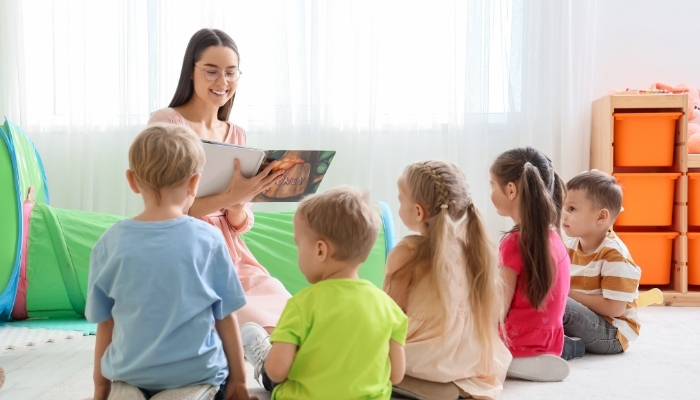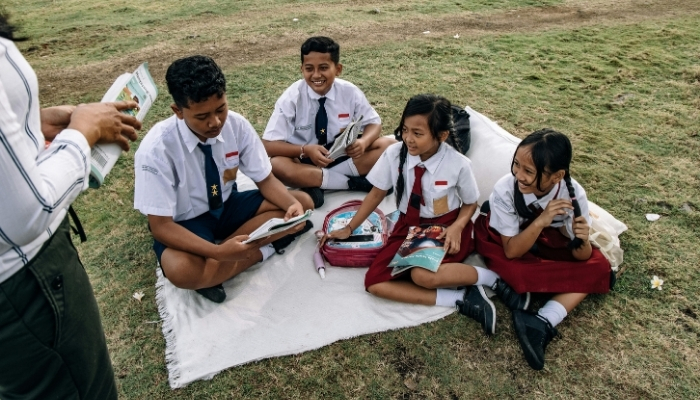Every child learns to read at their own pace; some quickly catch on to letter sounds, while others need a little extra time and support. That’s where guided reading groups come in. In a kindergarten classroom, these small, focused sessions help children develop reading fluency, confidence, and comprehension in a supportive setting.
When guided well, these groups create a space where young learners can explore books just right for their level, not too hard, not too easy, while teachers provide tailored guidance and feedback.
Let’s explore what guided reading groups are, how they work, and why they’re such an effective part of early literacy instruction.
Quick Summary
-
Guided reading groups in kindergarten help children transition from learning letter sounds to becoming confident, independent readers.
-
Small-group sessions allow teachers to tailor instruction, focusing on phonics, fluency, comprehension, and vocabulary.
-
Key benefits include improved confidence, stronger decoding skills, and better engagement through peer interaction.
-
Common challenges, like managing different reading levels or maintaining focus, can be overcome with structured routines and engaging materials.
-
FunFox’s approach integrates guided reading with interactive lessons and personalised feedback, ensuring every child progresses at their own pace.
What Are Guided Reading Groups in Kindergarten?
Guided reading groups are small, teacher-led sessions that bring together children with similar reading abilities. Each group reads a carefully selected book while the teacher supports their decoding, fluency, and comprehension skills.

Unlike whole-class reading, guided reading allows for:
-
Personalised attention: teachers can meet each child where they are.
-
Targeted instruction: lessons are built around current reading goals.
-
Active engagement: every child reads, discusses, and participates.
In kindergarten, these sessions usually include 3–6 students, making it easy for teachers to observe progress closely and adjust lessons based on each child’s needs.
Why Guided Reading Groups Matter for Young Learners
Guided reading groups help bridge the gap between learning letter sounds and becoming confident, independent readers. When children read in small groups, they feel supported and encouraged, and that’s key to developing a love for books early on.
Key benefits include:
-
Building phonemic awareness through guided sound practice: Small-group settings allow teachers to focus on the specific sounds and blends children are learning. Through repetition and targeted feedback, students strengthen their ability to hear, recognise, and manipulate sounds essential for decoding new words.
-
Strengthening fluency and comprehension through repeated reading: As children reread familiar texts, they improve their reading pace, accuracy, and expression. This helps them shift from decoding words to understanding meaning, which is the ultimate goal of reading.
-
Encouraging confidence and participation in a low-pressure setting: Reading aloud in front of the entire class can be intimidating for early learners. Guided groups create a safe, supportive space where children can practise reading and make mistakes without fear of embarrassment.
-
Allowing individualised teaching without isolating students: Teachers can address each child’s specific needs, whether it’s decoding support, vocabulary building, or comprehension questions, all while maintaining the collaborative energy of group learning.
Research consistently shows that differentiated small-group instruction is one of the most effective ways to improve early literacy outcomes, helping every child progress at their own pace while staying engaged and motivated.
Also Read: Engaging Reading Fluency Games for Students
How to Organize Guided Reading Groups in Kindergarten
Creating effective guided reading groups in kindergarten is all about balance, structure with flexibility, and planning with responsiveness. The goal is to ensure that every child receives the right level of challenge and support, so their reading confidence grows naturally.

Here’s how teachers can set up guided reading groups successfully:
-
Assess current reading abilities: Start with simple reading assessments or observations. Identify how children handle letter-sound correspondence, sight words, and comprehension. This helps group students by similar skill levels rather than age or grade alone.
-
Form small, flexible groups: Ideal groups include 3–6 students, allowing teachers to listen closely and give direct feedback. Keep groups fluid; children should move between groups as their skills develop.
-
Choose texts thoughtfully: Select books that are just right, challenging enough to build new skills but not so difficult that they cause frustration. Decodable readers, short picture books, and repetitive texts work wonderfully at this stage.
-
Plan short, focused sessions: Each guided reading session should run for about 15–20 minutes. Begin with a brief warm-up (such as revising sight words), move to shared reading, and end with a short discussion or activity to check comprehension.
-
Rotate groups regularly: Aim to meet each group several times a week. Meanwhile, set up literacy centres, independent reading corners, or word games for other students to keep everyone engaged while you work with one group.
-
Track progress continuously: Keep simple notes after every session, including which words children struggled with, what strategies worked, and what needs reinforcement next time.
Guided reading groups work best when teachers stay flexible, responsive, and consistent. Over time, even hesitant readers begin to participate more eagerly, showing steady progress in fluency and comprehension.
Also Read: Reading Comprehension Games and Activities for Students
Practical Strategies and Engaging Activities for Guided Reading
Once guided reading groups are set up, the real magic happens through how the sessions are run. The key lies in blending structure with engagement, ensuring every child feels involved, challenged, and excited to read.

Here are some powerful strategies and activities to make guided reading sessions truly effective:
-
Model expressive reading aloud: Begin each session by reading a short section aloud. This helps children hear the rhythm, tone, and expression of fluent reading. When students listen to their teacher model good reading, they begin to mimic those same patterns naturally.
-
Use gentle prompts and guidance: When a child struggles with a word, offer a hint based on phonics or meaning instead of answering. For example, say, “What sound does that first letter make?” or “Can you look for a smaller word inside that word?” This promotes independent problem-solving and decoding skills.
-
Incorporate word work: After reading, reinforce key sounds or sight words from the book. Activities like word sorts, blending games, or spelling with letter tiles make it hands-on and memorable.
-
Encourage rereading: Have children reread familiar stories to build confidence, fluency, and expression. Rereading also deepens comprehension since kids can focus on meaning rather than just decoding.
-
Ask comprehension questions: Go beyond “What happened?” and ask open-ended questions such as, “Why do you think the character did that?” or “How would you feel in that situation?” These conversations help young readers connect personally to the story.
-
Include visual and sensory supports: Use pictures, props, or gestures to make stories come alive. Visuals help children retain information better and make abstract concepts easier to grasp.
-
Make group discussions interactive: Let each child share their favourite part, guess what might happen next, or act out a scene. These moments encourage participation and improve oral language skills.
-
Rotate roles during sessions: Some days, a child might be the “page turner,” another day the “word detective” who spots a target sound or sight word. These mini responsibilities make reading groups more engaging and fun.
Example: If the group is reading “The Big Cat Nap,” the teacher might:
-
Start with a warm-up game on short vowel sounds.
-
Read the story together, prompting children to blend and decode words like cat, nap, and mat.
-
Discuss what made the cat sleepy and how the story ended.
-
Wrap up with a rhyming word hunt from the text.
Also read: Discover the Magic: Top Picks for Reading Short Stories Online with Kids.
Overcoming Common Challenges in Guided Reading Groups
Even the most well-planned guided reading sessions come with challenges. Every child learns differently, and balancing group needs can take patience and strategy. The good news is that most obstacles can be addressed with thoughtful adjustments.

Here are a few common challenges and how to overcome them effectively:
-
Challenge: Students at very different reading levels: It’s common for a kindergarten class to have a wide range of reading abilities. Instead of fixed ability groups, use flexible grouping, adjusting group members as children progress. Reassess every few weeks so that instruction always matches current skill levels.
-
Challenge: Limited time for each group: Short sessions often mean teachers feel rushed. To manage time efficiently, focus each session on one clear objective, for instance, decoding short vowels or improving fluency. Rotate through groups on alternate days and use independent literacy centres to keep other students meaningfully engaged.
-
Challenge: Selecting the right reading material: Finding books that are both level-appropriate and interesting can be tricky. Choose short, decodable texts for early readers and gradually introduce storybooks that build comprehension. FunFox’s decodable readers, for example, align with phonics stages and include engaging visuals that support understanding.
-
Challenge: Keeping all students engaged: In small groups, attention can wander quickly. Incorporate active participation, let children act out scenes, use gestures, or track words with their fingers while reading. Short, varied tasks help maintain focus and energy.
-
Challenge: Measuring progress consistently: Some students may progress quickly, while others need more reinforcement. Keep a simple observation log after each session. Note decoding accuracy, fluency improvements, and comprehension responses. These quick records make it easier to tailor future lessons to each child’s needs.
When teachers use guided reading as a flexible, responsive tool rather than a rigid schedule, students thrive.
Also read: How to Make Reading Fun for Kids: 20 Easy Tips
Help Your Child Thrive with the FunFox Readers Club
The FunFox Readers Club is an engaging, evidence-based reading programme for children aged 6 to 14 (Years 3–8). Built around the Australian Curriculum, it helps every learner strengthen fluency, comprehension, and reading confidence in a supportive small-group environment.
Whether your child loves reading or needs a little encouragement, Readers Club makes every session exciting, purposeful, and tailored to their progress.
-
Small-Group Online Lessons: 3–6 students per class for personalised guidance and peer learning.
-
Expert Teachers: Skilled educators trained in the FunFox Way, combining structure with creativity.
-
Weekly 1-Hour Zoom Sessions: Flexible, consistent, and accessible from home.
-
Interactive Learning Tools: Digital games, reading worksheets, and fun online resources.
-
Recorded Sessions: Easy replays so your child never misses a lesson.
-
Continuous Feedback: Process-based insights that track growth and celebrate effort.
-
Evidence-Based Framework: Lessons designed around proven literacy-building methods.
-
Focus on Confidence and Joy: Every activity nurtures curiosity and a love for reading.
If you’re ready to help your child read with confidence and enjoyment, FunFox Readers Club is the perfect place to start.
Final Words
Guided reading groups are where young readers truly begin to thrive, blending structured learning with joyful discovery. When children read in small, supportive groups, they not only master sounds and words but also build the confidence to express themselves and enjoy books independently.
FunFox brings this experience to life through its Readers Club, where every lesson is designed around engagement, encouragement, and evidence-based reading strategies. With passionate teachers, small class sizes, and the proven FunFox Way, each child receives the attention they need to grow at their own pace.
Help your kindergartener build confidence and reading fluency with guided, small-group lessons that make learning fun and effective.
FAQs
1. What are guided reading groups in kindergarten?
Guided reading groups are small, teacher-led sessions where children with similar reading levels learn together. These sessions focus on skills like phonics, comprehension, and fluency through targeted, interactive instruction.
2. How many students are usually in a guided reading group?
Most guided reading groups include 3–6 students. This small size allows teachers to provide individual attention while encouraging teamwork and confidence among young learners.
3. What types of books are used in guided reading?
Teachers use leveled readers that match each child’s current skill level. These books gradually increase in difficulty, helping children practise decoding, sight words, and comprehension in manageable steps.
4. How often should guided reading groups meet?
Ideally, groups meet several times a week for short, focused sessions (10–20 minutes). Frequent, consistent practice helps children retain skills and develop reading fluency faster.
5. How can FunFox support my child’s guided reading progress?
FunFox’s Readers Club follows the principles of guided reading through small-group online lessons, structured phonics practice, and interactive activities. Each child receives personalised feedback to strengthen confidence and comprehension.















